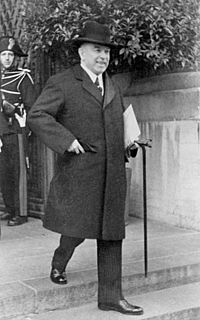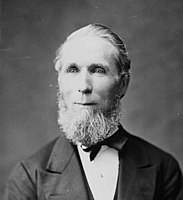
The Canadian federal election of 1921 was held on December 6, 1921, to elect members of the House of Commons of Canada of the 14th Parliament of Canada. The Union government that had governed Canada through the First World War was defeated, and replaced by a Liberal government under the young leader William Lyon Mackenzie King. A new third party, the Progressive Party, won the second most seats in the election.

The Canadian federal election of 1867, held from August 7 to September 20, was the first election for the new nation of Canada. It was held to elect members to the House of Commons of Canada, representing electoral districts in the provinces of Nova Scotia, New Brunswick, Ontario and Quebec in the 1st Parliament of Canada. The provinces of Manitoba (1870) and British Columbia (1871) were created during the term of the 1st Parliament of Canada and were not part of the Canadian federal election of 1867.

The Canadian federal election of 1896 was held on June 23, 1896, to elect members of the House of Commons of Canada of the 8th Parliament of Canada. Though the Conservative Party won a plurality of the popular vote, the Liberal Party, led by Wilfrid Laurier, won the majority of seats to form the next government.

The Canadian federal election of 1872 was held from July 20 to October 12, 1872, to elect members of the House of Commons of Canada of the 2nd Parliament of Canada. Prime Minister Sir John A. Macdonald's Conservative Party remained in power, defeating the Liberals. However, the Liberals increased their parliamentary representation considerably, while the Conservative seat count remained static, giving them only five more seats than the Liberals. This technically resulted in the country's first minority government, though the support of two independent Conservative MPs functionally gave Macdonald an extremely slim majority.

The Canadian federal election of 1891 was held on March 5 to elect members of the House of Commons of Canada of the 7th Parliament of Canada. It was won by the Conservative Party of Prime Minister Sir John A. Macdonald.

The Canadian federal election of 1925 was held on October 29 to elect members of the House of Commons of Canada of the 15th Parliament of Canada. Prime Minister William Lyon Mackenzie King's Liberal Party formed a minority government. This precipitated the "King–Byng Affair".

The Canadian federal election of 1874 was held on January 22, 1874, to elect members of the House of Commons of Canada of the 3rd Parliament of Canada. Sir John A. Macdonald, who had recently been forced out of office as prime minister, and his Conservatives were defeated by the Liberal Party under their new leader Prime Minister Alexander Mackenzie.

The Canadian federal election of 1935 was held on October 14, 1935. to elect members of the House of Commons of Canada of the 18th Parliament of Canada. The Liberal Party of William Lyon Mackenzie King won a majority government, defeating Prime Minister R. B. Bennett's Conservatives.

Joseph-Édouard Cauchon, was a prominent Quebec politician in the middle years of the nineteenth-century. Although he held a variety of portfolios at the federal, provincial and municipal levels, he never achieved his goal of becoming the Premier of Quebec.

The Canadian federal election of 1926 was held on September 14 to elect members of the House of Commons of Canada of the 16th Parliament of Canada. The election was called following an event known as the King–Byng affair. In the 1925 federal election, Prime Minister William Lyon Mackenzie King's Liberal Party of Canada won fewer seats in the House of Commons of Canada than the Conservatives of Arthur Meighen. Mackenzie King, however, was determined to continue to govern with the support of the Progressive Party. The combined Liberal and Progressive caucuses gave Mackenzie King a plurality of seats in the House of Commons, and the ability to form a minority government. The agreement collapsed, however, following a scandal, and Mackenzie King approached the Governor-General, Baron Byng of Vimy, to seek dissolution of the Parliament. Byng refused on the basis that the Conservatives had won the largest number of seats in the prior election, and called upon Meighen to form a government.

The Canadian federal election of 1900 was held on November 7 to elect members of the House of Commons of Canada of the 9th Parliament of Canada. As a result of the election, the Liberal Party, led by Prime Minister Wilfrid Laurier, was re-elected to a second majority government, defeating the Conservative Party and Liberal-Conservatives led by Charles Tupper.

The Canadian federal election of 1882 was held on June 20, 1882, to elect members of the House of Commons of Canada of the 5th Parliament of Canada.

The Canadian federal election of 1887 was held on February 22, 1887, to elect members of the House of Commons of Canada of the 6th Parliament of Canada.

This article is the Electoral history of Sir John A. Macdonald, the first Prime Minister of Canada.

This article is the Electoral history of Alexander Mackenzie, the second Prime Minister of Canada. A Liberal, he served one term as Prime Minister. He became Prime Minister after defeating the government of Sir John A. Macdonald on a non-confidence motion in 1873 and then winning the general election of 1874. He later lost the general election of 1878 and Macdonald returned to power.

This article is the Electoral history of Sir Mackenzie Bowell, the fifth Prime Minister of Canada. A Conservative, he became prime minister upon the sudden death in office of Prime Minister Sir John Thompson in 1894. Bowell served a short term of just over one year as prime minister (1894-1896), until he was forced to resign over the Manitoba Schools Question. He never led his party in a general election. When he died in 1917, he was one of the last surviving members of the first House of Commons of Canada elected in 1867.

This article is the Electoral history of Sir Charles Tupper, the sixthth Prime Minister of Canada. A Conservative, he became prime minister upon the resignation of Prime Minister Sir Mackenzie Bowell over the Manitoba Schools Question in 1896. Tupper was the shortest-serving prime minister, with a term of only 68 days. He led his party in two general elections and lost both, to Sir Wilfrid Laurier

The article is the Electoral history of Arthur Meighen, the ninth Prime Minister of Canada.

This article is the Electoral history of William Lyon Mackenzie King, the tenth Prime Minister of Canada. A Liberal, he was Canada's longest-serving Prime Minister, with three separate terms as Prime Minister, for a total of 21 years and 154 days. He defeated Prime Ministers Arthur Meighen and R.B. Bennett at different times, and was succeeded by Prime Minister Louis St. Laurent in 1948.





















